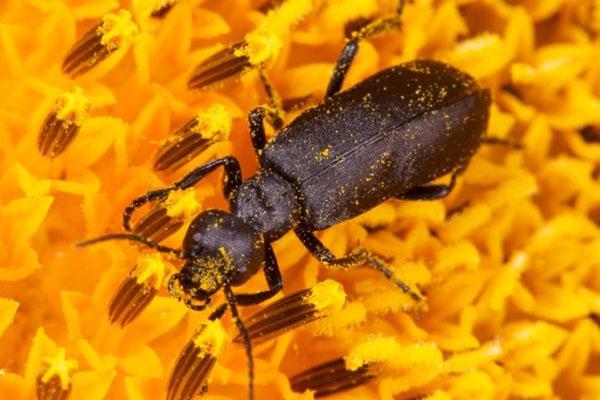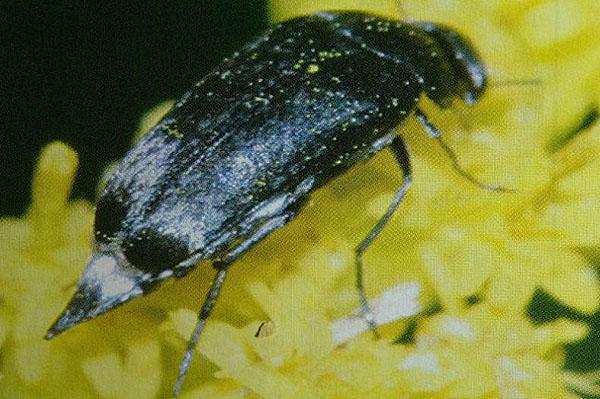The most dangerous pests of sunflower: description of species, methods of control
 Appetizing seeds, vegetable oil, cake and sweet halva are obtained from a unique "sunny" plant. However, annoying sunflower pests prevent farmers from growing a bountiful harvest. What will help to recognize dangerous insects and save the culture from death? Of course, a detailed description of the "enemies" and effective methods of dealing with them.
Appetizing seeds, vegetable oil, cake and sweet halva are obtained from a unique "sunny" plant. However, annoying sunflower pests prevent farmers from growing a bountiful harvest. What will help to recognize dangerous insects and save the culture from death? Of course, a detailed description of the "enemies" and effective methods of dealing with them.
Sunflower pests: close acquaintance and methods of struggle

They often damage various parts of the plant, including:
- stems;
- seeds;
- baskets;
- leaves;
- young shoots.
However, the most common pests of sunflower are poly-eating insects. Let's take a closer look at some of them.
The plant loves fertile soil and warm climate. Therefore, it is attacked by various insects.
Sunflower thornbearer
 The insect is a miniature black beetle. Its length is about 5 cm. The outer part of the body is covered with small gray hairs. An elongated spine is located on the abdomen. The cute antennae resemble dense silk threads. They decorate the head, which is always down. The miniature legs are colored yellow-red.
The insect is a miniature black beetle. Its length is about 5 cm. The outer part of the body is covered with small gray hairs. An elongated spine is located on the abdomen. The cute antennae resemble dense silk threads. They decorate the head, which is always down. The miniature legs are colored yellow-red.
The sunflower spikelet lays its eggs in the secluded sinuses of the leaf plates. Over time, offspring appear there. Yellow larvae with a brown head and hairy back penetrate into the core of the plant stems. There they make many moves, gradually destroying them. When autumn comes, pupae form from the larvae. Then they hibernate. In addition, thorn beetles carry some viral and fungal infections.
The pest begins to infect the plant from the bottom. It often feeds on about a third of the powerful stem.

To effectively deal with the shyponoska, it is necessary to carry out:
- deep plowing of the land;
- harvest in a timely manner;
- processing with special chemicals.
An integrated approach to business helps to protect the plant from pests and to collect a bountiful harvest.
Meadow moth
 Most often, the insect is found in the steppe or forest-steppe zone, where sunflower is cultivated. Therefore, it is considered the most dangerous pest of sunflower. The butterfly reaches a length of about 25 mm. Her wings are light brown. A light spot can be seen in the center. Insects especially dangerous during the period of mass reproduction. This occurs in early spring when the temperature reaches about 15 ° C. The first generation appears at the end of June, the second in August, and the third in September. It reaches full development in 50 days.
Most often, the insect is found in the steppe or forest-steppe zone, where sunflower is cultivated. Therefore, it is considered the most dangerous pest of sunflower. The butterfly reaches a length of about 25 mm. Her wings are light brown. A light spot can be seen in the center. Insects especially dangerous during the period of mass reproduction. This occurs in early spring when the temperature reaches about 15 ° C. The first generation appears at the end of June, the second in August, and the third in September. It reaches full development in 50 days.
When a meadow moth settles on a sunflower, its greenery immediately suffers. Caterpillars feed on:
- young foliage;
- cuttings;
- stems;
- seeds.
As a result of their vigorous activity, “garlands” of cobwebs appear in culture. It was noticed that the pest can destroy about 60% of the crop, or even all the plants. Therefore, it is important to take measures to protect the sunflower.
First of all, it is necessary to reduce the number of insects and stop their reproduction. To do this, the plantings are examined every 5 days to find the larvae or caterpillars of the moth. Once the pests have been identified, suitable insecticides are used.
It is advisable to use chemicals when young prairie moth caterpillars appear on the crop.
It is important to regularly weed the crop, huddle and remove weeds from the field. After all, it is there that the females lay eggs and the caterpillars hibernate.
Sunflower barbel
 The maximum pest size is approximately 21 mm. The body is painted in black shiny color. On top of it are wings with a spotted yellow pattern that is formed from miniature hairs.
The maximum pest size is approximately 21 mm. The body is painted in black shiny color. On top of it are wings with a spotted yellow pattern that is formed from miniature hairs.
Sunflower larvae barbel painted in white and yellow. They reach about 27 mm in length. They have no legs, but only a flat abdomen. The brown head shines brightly in the sun. The first segments of the larva have a thickened structure, and the latter is abundantly covered with red bristles. In general, the shape of the torso resembles a curved arc. They hibernate inside the basal stems of a sunflower. In early spring, the larvae pupate, and beetles appear in June.
The best way to protect your crop from barbel:
- early sowing;
- timely cleaning of weeds;
- deep plowing of the soil after harvest.
Plants affected by the barbel stagnate, break and wither prematurely.
Graceful Slow Beetle
 The insect, about 8 mm in size, is covered with a "strong" shell. It skillfully disguises itself as the topsoil, so it is difficult to notice it. The pest develops in 40 days. The maximum life span is approximately 2 years. The lingering beetle larvae resemble click beetles. However, their front legs are larger than the rest. The head is slightly convex and the upper lip is especially developed.
The insect, about 8 mm in size, is covered with a "strong" shell. It skillfully disguises itself as the topsoil, so it is difficult to notice it. The pest develops in 40 days. The maximum life span is approximately 2 years. The lingering beetle larvae resemble click beetles. However, their front legs are larger than the rest. The head is slightly convex and the upper lip is especially developed.
The pest comes out of hibernation at the first warming. Therefore, when sunflower seedlings appear on the surface, they are ready to start eating. Beetles gnaw at young shoots of the crop, thus destroying the crop.
The most effective methods of dealing with the lingering beetle include several activities:
- deep autumn plowing of the land;
- soil treatment with special preparations;
- weeding weeds;
- timely sowing of culture;
- plant feeding.
In addition, seeds are treated with insecticides before sowing. In the fall, after harvest, the plant is cut as close to the ground as possible. All tops are taken out of the field. The implementation of all measures helps to protect the plant from beetles. As a result, the crop yield increases.
Having got acquainted in detail with sunflower pests and measures to combat them, you can safely grow such a useful crop. The main thing is to find a miniature enemy in time and act in accordance with the basic rules of plant protection.